Road Trip: Day Eight
Day Eight, Palo Duro Canyon, TX to Santa Rosa Lake State Park, NM
08.00am
Courtney finds a gobble of eleven wild turkeys outside the bathrooms. They’re pecking about in the half-light because although the sun has risen, we’re sheltered from it by the sandstone walls around us.
As I shower in the bug-ridden bathrooms I notice a large shadow on the shower curtain. I decide to ignore it for the moment. Later, dried off and with contact lenses in, curiosity gets the better of me. I go back to the shower curtain and draw it back to reveal a large locust, five inches from tip to tail.
08.15am
The sun rises over the rim of the canyon. Apart from the wild turkey, everything is asleep: the deer, the woodpeckers and roadrunners, even the flies are slumbering.
08.50am
Courtney and I set out on a hike through the canyon. The guidebook tells us that Palo Duro means hard wood, so the canyon was named after the mesquite trees that grow within it. It’s a week day, so we have the park entirely to ourselves for a couple of hours. The only noise is the sound of our feet on the dusty canyon floor.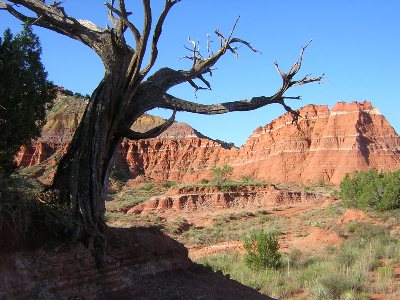
The landscape of Palo Duro is very fragile. Mostly sandstone with some clay, the pretty peaks, columns and ridges would be quickly worn away in a climate as wet as England’s. We guess that it must rain once a month at most here.
The lady who checked us into the campsite warned us to look out for rattlesnakes when walking the trails. We remain on the lookout, but we spot only one snake, darting away into a crevice. It doesn’t even have a rattle on its tail. Of the other wildlife in the canyon, the wild turkey and deer are very tame. In all national and most state parks, hunting is forbidden. These unsuspicious creatures have grown to maturity not fearing the presence of humans and we can get up close for a good look before they even think of moving away. There are roadrunners, too. Bigger than a pigeon, but smaller than a pheasant, bluish-black in colour with a pointed beak and small crest on the back of the head. We see them, not on the trail, but skittering up and down the road beside the car. At Kelvin’s behest, I must insert a "meep-meep" here.

We’re heading for the best-known landmark in the park, a rocky outcrop known as the lighthouse, for obvious reasons. The four and a half six mile hike takes us just under three hours.
13.00pm
Back on the road, through Amarillo again. I hope this time it doesn’t mess with my head so much.
14.00pm
Amarillo was fine today. I blame the bad sandwich from Childress for my weird mood yesterday. On the outskirts of town we stop at the Cadillac Ranch, ten 1950’s Cadillacs upended in the ground, covered with paint and graffiti. On one of the wheels someone has written “Oddly, this is Amarillo’s biggest tourist attraction.” Why so odd?
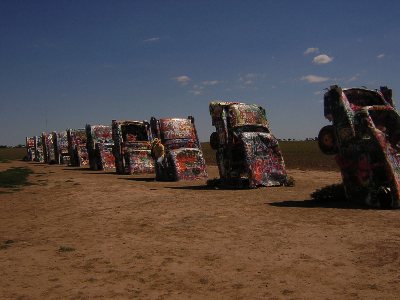
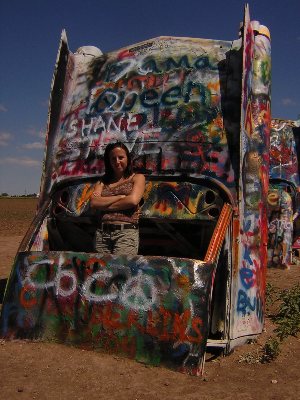
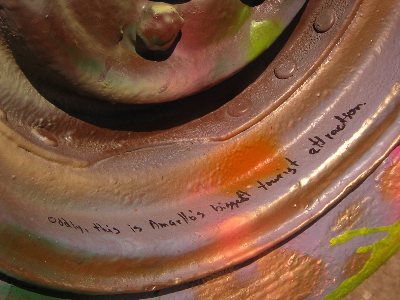
Courtney tells me Amarillo is Spanish for yellow.
15.05pm
We catch sight of our first crop dusting plane of the trip. Mmm. North by Northwest.
15.20pm
Finally, an end to the nothingness. As we near New Mexico the land starts to sweep gently down from jagged ridges dotted with round green bushes to undulating plains cracked with small canyons and rivers. The land is high to our right, and curves away down to our right. I can’t even estimate how far we can see. On a good day from the top of the Malverns you can see Wales, so they say, which is maybe fifty miles. We can see that far, but we’re not even looking from the top of a hill. Where I found the land around Amarillo featureless and oppressive, this landscape is an uninhabited wilderness. It’s beautiful.
15.30pm
No more Texas. As we cross into New Mexico the clocks go back an hour for mountain time.
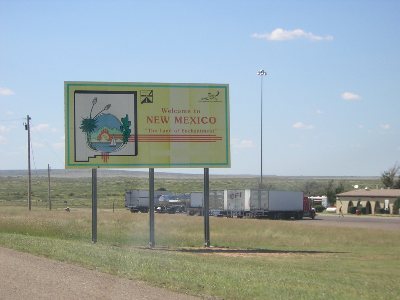
17.35pm
The town of Santa Rosa is little more than a truck stop. There’s the usual line of petrol stations, fast food restaurants and a small food mart. There’s also a new car distribution centre, a few acres just off the railroad hemmed in with high security fences. A convoy of car transporters are pulling in as we drive past. It’s not a place to fire the imagination.
The route to the lake takes us through a run-down residential area. About five miles out of town is the state park. We follow the signs for the "Primitive Campground," and it really is primitive. The area is unmanned: you slip your payment into a little post box and choose your site, which is a rectangle of gravel and a picnic table. We’re the only people there. Courtney looks very nervous at the prospect of staying the night here.
We drive on through the park to find out if there are any other camp grounds. A couple of miles further on we see the sign for "Developed Campgrounds." There’s still no sign of a ranger, but there are plenty of other campers, most of them in winnebagos. Courtney breathes an audible sigh of relief. It’s windy up here, but the bathroom is refreshingly devoid of insects and we have a sweeping view of the "lake," which is actually a man-made reservoir.
